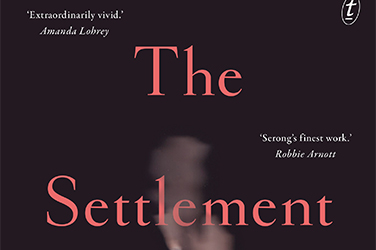
- Free Article: No
- Contents Category: Fiction
- Review Article: Yes
- Article Title: ‘How will it end?’
- Article Subtitle: The terrible ironies of colonial ambition
- Online Only: No
- Custom Highlight Text:
A third of the way through Jock Serong’s sixth novel, The Settlement, a woman asks her new husband a pointed question about Wybalenna, the desolate Tasmanian community in which she finds herself, a community of duplicitous, expedient, and brutally deranged white men and the First Nations Tasmanians they seek to subjugate. ‘How will it end? His wife had asked him when she first arrived. Will the paddock fill and the people empty? Will there be another paddock after this one, if there are more people coming?’ Her husband, the storekeeper of the settlement, is witness to the grim activities of the governing group. He sees terrible cruelties he is largely powerless to prevent. The paddock she asks about is a cemetery.
- Article Hero Image (920px wide):

- Article Hero Image Caption: Jock Serong (photograph by Fred Kroh/Text Publishing)
- Alt Tag (Article Hero Image): Jock Serong (photograph by Fred Kroh/Text Publishing)
- Featured Image (400px * 250px):

- Alt Tag (Featured Image): Brenda Walker reviews 'The Settlement' by Jock Serong
- Book 1 Title: The Settlement
- Book 1 Biblio: Text Publishing, $32.99 pb, 302 pp
- Book 1 Readings Link: booktopia.kh4ffx.net/JrMkmE
Serong’s previous novels include crime and historical fiction, and his influences are very literary. Traces of Charles Dickens, Cormac McCarthy, and Patrick White thread through his prose, which is often genre-based – the agile plotting and unexpected metaphor of Raymond Chandler is apparent here. By imaginatively revisiting the history of George Augustus Robinson, who played an active part in the removal from traditional lands and attempted cultural suppression of Aboriginal Tasmanians, Serong joins many other Australian writers, including Robert Drewe and Richard Flanagan. The Settlement is deeply connected to history and prior literature through style and subject matter, but its emphatic concern with miscommunication as an instrument of resistance and evasion, and its use of canonical literature at points of crisis and of soundscapes to represent country, are distinctive.
The novel has three parts. The first, set in October 1831, describes Robinson’s attempt to locate the Lairmairermener people and persuade them to abandon their land. There can be no trust between Robinson, or ‘the Man’ as he is called at this point, and his so-called emissary to these people, Mannalargenna, who has been trying to resist directives. Mannalargenna’s strategic disengagement is partly linguistic: ‘He would seem puzzled ... The chief would play at confusion, and it would make the Man even more bellicose’; partly defiant: ‘The chief would either glare at him or ignore him altogether’; and partly theological – he is guided by a ‘devil’, which certainly distinguishes him from the evangelising Robinson. As one member of the group observes, ‘There wasn’t room for some people to have devils and for everyone to have Jesus.’ These are obvious points of resistance and difference, but there are more subtle disconnections between members of the search party: thoughts are ‘concealed’, experience is ‘hidden’, the understanding of events is ‘private’; perhaps the most significant conversation, where representatives of two First Nations peoples meet, occurs out of earshot. Wordsworth’s poetry, read by campfire light, seems to evaporate into darkness. English literature is out of place here. Direct communication, such as the Man’s statement that ‘We – Englishmen – pursue a duty to bring light to darkness. Civilisation’, is bizarre, especially under these circumstances. This is an oblique story, and the deliberate obliquity is political.
The second part of the novel, set between 1833 and 1835, acts as a bridge between the Man’s contact with the Lairmairermener people and his version of civilisation – a settlement where children are cowed, brutalised, and even killed, and the body parts and artefacts of dead First Nations people are shipped off to buyers in the northern hemisphere. In this section, historical portraits of Aboriginal people – Truganini, Woorady, and Mannalargenna – are accompanied by brief monologues, ostensibly voiced by the artist, speaking directly to his sitter. It’s a one-sided record of conversation in which Aboriginal people are occasionally quoted, but their contribution is indirect and largely opaque. The text does not pretend to represent them, implicitly pointing to the limitations of such portraiture.
The final and most powerful part of the novel is set at the end of 1835, in the settlement that Robinson, now styled ‘the Commandant’, recognises as ‘a warehouse for the natives’, a place of strange noises and words that mean nothing to him. There is a desolate soundscape in this settlement – ‘[wind] flowed through the tough fronds of the she-oaks, and each frond made a tiny thrum over its fluted surface as it whipped the air and all of them, collectively, built the moaning’. Mannalargenna will not relinquish his distinguishing ochre or his language, and as he dies, less than two months after his arrival, he engages the Commandant in a formal dialogue about the keeping of faith, about trust and protection. This is the core of the matter, the time of reckoning for the Commandant, and Mannalargenna’s blunt appraisal of his actions is an act of direct communication that contrasts with his earlier evasions. It is especially potent because the dying man is aware that his adversary plans to render and sell his remains, and to lie about his salvation.
The Settlement is about the terrible ironies of ambition, an ambition which is founded on the destructive project of colonisation. The Commandant is convinced that his legacy will be literary: his writing will consolidate his version of history and bring him fame. Like the historical Robinson, he documents everything that he can comprehend in his journal. Serong makes the limits of this comprehension clear. The Commandant’s confidence in the endurance of his writing is ironically correct, in that in Jock Serong’s hands it inspires such an accomplished and imaginative refutation of his actions and his faith.


Comments powered by CComment